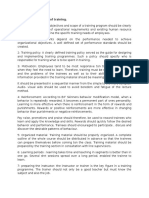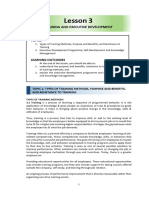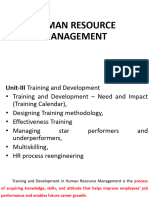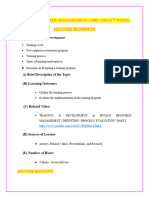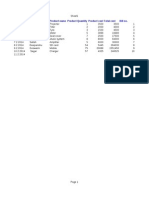Course - Brochure Management of Training: Synopsis
Course - Brochure Management of Training: Synopsis
Uploaded by
John CarpenterCopyright:
Available Formats
Course - Brochure Management of Training: Synopsis
Course - Brochure Management of Training: Synopsis
Uploaded by
John CarpenterOriginal Description:
Original Title
Copyright
Available Formats
Share this document
Did you find this document useful?
Is this content inappropriate?
Copyright:
Available Formats
Course - Brochure Management of Training: Synopsis
Course - Brochure Management of Training: Synopsis
Uploaded by
John CarpenterCopyright:
Available Formats
1
COURSE - BROCHURE
MANAGEMENT OF TRAINING
SYNOPSIS
The ultimate aim of training as a process is improvement of job-performance. The
success of any training effort is directly related to its job relevance.
THE TRAINING FUNCTION
In order to improve performance through training intervention the client
organizations and the training institutions need to act together. The training course, needs
to be preceded by Training Need Analysis and followed by improved services. The
Training function encompasses all activities aimed at improving the performance with the
help of training interventions and includes:-
i. advising management in formulation of training and development policy;
ii. preparing training plans and deciding training priorities;
iii. identification of training needs;
iv. providing learning opportunities to the employees.
ROLE OF TRAINING MANAGER
The training managers role in the training function will be to:-
1. Help implement Cadre Training Plan.
2. Organise studies for Identification of Training Needs (ITN).
3. Suggest training strategy.
4. Develop departmental training policy.
5. Organise in-house Training/Seminars.
6. Nominate personnel for training.
7. Identify areas for Distance Learning material/Performance Aids.
8. Getting need based design developed.
9. Getting training material developed.
10. Costing of Training.
11. Liaison with Training Institutions.
12. Organise impact studies.
13. Managing training resources.
14. Organise On the Job Training (OJT).
15. Draft Terms of Reference (TOR) for contracting.
16. Prepare Annual Training Plan.
17. Develop and Maintain Training Information System (TIS).
2
AIM OF THE COURSE
To train Training Managers for implementation of Training Policy in Ministries /
Departments / Organisations.
BENEFITS
The course will help build capabilities to :-
i. establish training function in the department as envisaged in National Training
Policy;
ii. adopt training function to effectively support governments initiatives and reforms;
iii. implement training strategy of Training for All.
COURSE STRUCTURE
The structure of the course has three phases:-
Phase I - Distance Learning (Pre-course development)
Phase II - Workshop
Phase III - Project Design
Distance Learning (Phase-I)
This phase will provide the participants an opportunity to study the concept of
SAT and issues relevant to the management of training. The Distance Learning material
will be made available to the participants after the nominations are finalised and three-
weeks before the commencement of the workshop. Participants will be expected to
complete the study and exercises before the commencement of the Workshop.
Workshop (Phase-II)
The residential workshop will be run for one week. It will include activities
concerned with the application of concepts, practice, issues and problems associated with
management of the training function in the department. As the workshop will be run on
participative methods requiring individual attention the number of participants in the
workshop will be limited to 16, with two course-tutors.
Preparation of a Project (Phase-III)
The Training Manager, on completion of the Workshop, would be required to
submit a project within 4 weeks to the Course Coordinator.
3
ELIGIBILITY
The officers designated to perform the duties of Training-Manager would be from
the Ministries / Departments / State Government / Public Sector Undertakings / Agencies.
In organisations where training function does not exist, nominations may be made taking
into account the officers who would be associated with the training function after their
return from the course.
For the Training-Manager the expected level is that of Director, Deputy Secretary,
Under Secretary in the Central Secretariat and their equivalents in other offices.
COURSE FEE
There is no course fee. However, as the course is residential, the sponsoring
authorities are required to pay Rs.200 per day per participant, for lodging and boarding.
4
MANAGEMENT OF TRAINING
SYSTEMATIC APPROACH TO TRAINING (SAT)
The purpose of any organization, whether in Public Sector or in Private Sector, is
to provide goods and/or services to the customer-both internal and external. While the
assessment of the performance of a private sector organization can be determined by
factors such as profitability, return on capital, market share etc, the success of the public
sector is relatively difficult to determine owing a variety of reasons including absence of
competition, existence for social reasons, political factors, lack of yardsticks for
performance evaluation etc. However, looking from the other angle the performance can
also be adjudged on the basis of how the organization manages its resources, systems,
processes and the people. Of these, the human resources, which activate the other
resources and systems, play a decisive role on the performance of organizations.
Therefore, training and developing people hardly need to be emphasised and here lies the
significance of the training function which encompasses all activities and contributions
which help people to learn and improve their performance. Needless to say that the
training manager who is responsible for training activities in an organization plays a pivotal
role in the development of the people in the organization.
People always need to learn in new Knowledge and Skills to be up to date to perform their
function in the systematic and effective manner. This is more important when they are
working in Organization in these days of technological advancement, the Knowledge and
Skills learnt become out of date and obsolete very fast. There is, therefore, a constant
need to update knowledge and skills. The Organizations have responsibility to
continuously develop their human resources. Unfortunately this does not always
happens. They wake up when there is a problem i.e. a performance problem in the
organization. These problems affect the business results and the organizations have to
investigate into the reasons which are responsible for the problems. The problems might
arise because of a variety of reasons. There may be some thing wrong with the structure
or culture of the organization, ambiguity relating to the individuals or groups efforts vis-
a-vis organizational goals, mis-management of processes, lopsided deployment of
resources, lack of skilled man-power and so on and so forth. In case the performance
problem has arisen due to the lack of appropriate knowledge and skill of the people, there
is a need that the people learn appropriate knowledge and skills to perform better. In
other words there is a need to train the people because training helps them to learn -
quickly and effectively.
While the learning refers to naturally occurring process that may or may not
contribute to the persons job performance, training is a planed process which directs
learning towards achieving specific outcomes, leading to achieving performance objective.
Training has been defined as:
5
A planned process to modify attitude, knowledge or skill behaviour through
learning experience to achieve effective performance in an activity or range of
activities. Its purpose in the work situation, is to develop the abilities of the
individual and to satisfy current and future manpower needs of the organisation.
Systematic Approach to Training refers to this kind of training where the learning
is done in a planned and systematic way and is directed to job performance. Training is
preferred to a naturally occurring learning process because without training -
People may never learn how to perform the task properly
If they do learn, they will do so much more slowly without training
They are likely to learn a way that is wrong
Consequences of poor performance results in poor quality, customer complaints,
etc.
Once they learn the task wrongly it is very difficult to unlearn and then relearn
correctly.
What happens without a Methodical approach to Training? Some of the consequences
are:-
Training is unplanned
Training is seen as a fire fighting activity
Training is picked up by new starters from more experienced workers
Bad and good habits are passed on without recognition
A substantial amount of time is wasted
Dangerous work practices are subconsciously passed on and by definition,
seem to be endorsed by the organization
The effect on quality, efficiency and profitability can be disastrous
The effect on morale and motivation can be very negative
Systematic Approach and Training Cycle
When there is a need for training intervention, a systematic approach has to be followed
and the training must be linked with real performance problem. The Training Cycle or the
various stages in training are depicted in the following figure:
6
Figure
Some people describe this concept through the following acronym:
I - Identified Training
N - Need
D - Design
I - Implement
A - Assess
Identification of Training Needs
Performance problems are rarely caused simply through a lack of training. When carrying
out organizational training needs analysis, it is important to recognize that performance is
influenced by three factors:
1. Lack of knowledge or skill. This is an area where training is an essential component.
2. Lack of environmental support. This factor covers the availability of suitable
equipment, materials, systems and procedures, necessary for satisfactory performance.
3. Lack of Motivation. People may be well trained and have the necessary environmental
support, but may fail due to lack of motivation.
For any performance-related situation, concerning people and their training and
development, these three factors, in combination, are of vital importance. Thorough TNA
should highlight the significance of each of them, it will be a responsibility of management
and, in particular, training management to tackle them.
Identify Training
Needs
Plan and Design
Training
Implement
Training
PERFORMANCE
Assess
Results
7
The first stage of the Systematic Approach to Training is to identify the areas for
improvement and the nature of the problems as clearly as possible. The following
techniques are used to identify the training needs:
a) Organisational Training Needs Analysis is used to consider such questions as
policy, productivity, new technology and cost escalation. Rarely can we deal with
these issues in isolation. Producing a broad picture of where problems exist is
necessary and the contribution that training can make to overcoming them, with
any other action required to solve or reduce performance problems.
b) Job Analysis takes the analytical process a stage further by investigating in more
detail the jobs people do. This will provide information, for example, about tasks
they perform, areas of responsibilities and relationships with others. Although
other disciplines also use job analysis (e.g. job evaluation, and recruitment and
selection), when it is used to identify training needs it directs attention to the
competences required to do the jobs
c) Task Analysis investigates the procedures, knowledge, skills and attitudes needed
to ensure satisfactory performance of a jobs key tasks. The products of this
analysis provide the basis for training activities.
It may also sometimes be necessary to look beyond the skills required by
individuals. John Donne wrote No man is an Island and this quotation has particular
application to the Training Needs of individuals working as a team or in a defined
Department. To enable the team or a Department to work effectively and respond to
changes, it is necessary that individuals have the skills to cover the responsibilities of other
teams or Department members. This means, that there is often a training need for
individual that goes beyond the requirement of his or her defined job. Matrix can be used
to identify the training need of group or peoples. A requirement following the
identification of training needs is to produce a design brief which takes into account such
factors as:
The number of people who need to be trained.
The grouping of these people into areas of common training need.
Their location.
Their availability for training, taking into account
The timescale within which training should be implemented.
The budget or funding support available for both development and
implementation.
The availability of suitable trainers.
The institutional resources available.
The design brief establishes a professional link between training management and a client
8
Plan and Design Training
Once we have identified the full extent of the areas for improving performance, and have
identified training needs, the stage is set to plan and design an appropriate training. While
some training needs can be met with in the existing training provisions, some training
needs require special training provision. The design stage is concerned with planning to
make the best use of training resources and cover a whole range of training activities.
The constraints of Finance, facilities, personnel etc. have to be taken into consideration. It
is important that the training professional is absolutely clear what the trainee needs to
achieve as a result of completing the training. The design should focus the stated
outcomes of the training.
Identifying the Aim
The Aim is a general statement of what the Trainee should achieve as a result of attending
the Training Programme. For example.
This Training programme will give the participants a thorough understanding of how to
operate the Automatic Telephone Referral System.
Setting the Objectives
The Objectives are a more detailed definition of what the Trainee will be able to do after
having completed the Training . For example
Having successfully completed the Training Programme, learners will be able to:
Describe the capabilities of the system
Transfer calls
Hold calls until the recipient can answer
Divert calls to other staff
Programme and record messages
Implementing Training
This is the stage where people undertake learning activities. This requires an active
participation of the trainees as well as the trainers. Unlike teaching the training is a two-
way traffic in which both the learner and the trainer are more or less equal participants.
In fact, a trainer is like a facilitator who creates learning opportunities. The success of the
implementation depends on certain factors some of which are listed below:
The trainee recognizes the need for training
The trainee is sufficiently motivated to learn
During implementation this motivation is maintained or increased
The design of learning events is realistic within the context of the organization
9
Clearly defined objectives are used to direct learning activities
The trainers possess sufficient technical and instructional skills
Personnel in the organization who are associated with the training activities,
(management, supervisors and colleagues) support the application and
development of newly acquired knowledge, skills and attitudes.
Evaluation (assessment) of Training
Unless Training is fully evaluated, it is impossible to measure the success of the process.
The Aim of Evaluation is to determine whether Training has been successful
Ongoing Evaluation enables the Trainer to review progress and take appropriate
action
Evaluation enables the Trainer to continually update and adapt delivery to reflect
the changing needs of learners and organizations
It is important that evidence defining the success of the programme is available. This
evidence could be provided by seeking answers to the following questions:
1. What functions can the Trainee perform now, that he/she could not perform before
the training?
2. Has the Trainee met all of the objectives?
3. How has the training impacted on the Trainee and those working with and around
the Trainee?
4. Are there any changes in the Trainees behaviour and attitude to the job?
5. Where the objectives have not been met in full or, most importantly, the intended
outcomes have not been realized, is there provision for further or repeat training?
10
EXERCISE
ON
SYSTEMATIC APPROACH TO TRAINING
I. Please complete the following Questions:
1. Primary purpose of an Organisation is to provide __________________________
_____________________________________________________________________
_____________________________________________________________________
2. In the absence of the financial criteria assessment of the success of an organisation
can be judged by ___________________________________________________
__________________________________________________________________
_________________________________________________________________.
3. People need to be updated in knowledge and skills because __________________
__________________________________________________________________
_________________________________________________________________.
4. Systematic approach to training refers to that kind of Learning which __________
__________________________________________________________________
_________________________________________________________________.
5. Identification of training needs is important because _______________________
__________________________________________________________________
_________________________________________________________________.
11
II. Bring out one or two basic points of distinctions between:-
1. Performance-problem and Training-Need ________________________________
__________________________________________________________________
_________________________________________________________________.
2. Job-analysis and task-analysis _________________________________________
__________________________________________________________________
_________________________________________________________________.
3. Trainer and Training-Manager ________________________________________
__________________________________________________________________
_________________________________________________________________.
III. List out 4 consequences of unsystematic training.
1. ______________________________________
2. ______________________________________
3. ____________________________________
4. ____________________________________
IV. List out four stages in Training Cycle.
1. ___________________________________________________
2. ___________________________________________________
3. ___________________________________________________
4. ___________________________________________________
V. Please explain in one sentence your perception about the role of a
Training Manager.
______________________________________________________
__________________________________________________________
12
MINISTRY OF PERSONNEL, PUBLIC GRIEVANCES & PENSIONS
DEPARTMENT OF PERSONNEL & TRAINING
TRAINING DIVISION
MANAGEMENT OF TRAINING COURSE
ANDRAGOGY : A Technology for Adult Learning
13
ANDRAGOGY: A TECHNOLOGY FOR ADULT LEARNING
Most of us deplore the unnecessary use of jargon, and the term Andragogy falls
into this category. So why use it? Until fairly recent times training was associated with
younger people (apprentices, newly appointed recruits, for example), who once trained
could develop by gaining experience. The training process used was usually by some form
of teaching, or instruction often delivered to relatively for inexperienced trainees.
Now, we refer to these people as learners, and they are often mature, experienced adults
possibly facing major changes in their jobs, or prospects for employment. The concept of
andragogy, based on the writings of Malcolm Knowles, is of considerable significance
when considering entry behaviour and has relevance to training design.
Most of what is known about learning and the practice of teaching is derived from
studies of learning in children and animals. From this emerged the technology of
pedagogy - a term derived from the Greek stem PAID (meaning child), and
AGOGOS (meaning learning). So pedagogy means specifically, the art and science
of teaching children.
One problem is that the children aspect of the definition is often lost, and
pedagogy is defined as the art and science of teaching without any attempt to draw a
distinction between the child and the adult.
Pedagogy is also biased towards education, and is concerned primarily with the
transmission of knowledge. Historically, when major changes in culture and technology
were introduced only slowly, what people learn in their youth would remain valid for the
rest of their lives. Recent history has changed this concept dramatically. Knowledge
gained by the time a person is, say, 20 years of age may be obsolete by the time he or she
is 40. This is especially true in the world of work, where knowledge and skills acquired in
early adult life may be out of date by middle age. Therefore, as trainers, we are no longer
concerned with the pedagogical process of transmitting what is known and done, but
more towards a concern for a life-long process of discovering what is not known and
coping with the resulting change.
Experienced trainers are well aware of the limitations of traditional teaching
methods. Such methods, often requiring a trainer-centered technique, are satisfactory
when dealing with children or adolescents, but become less so when the learner is a
mature, experienced, adult. Adults are often voluntary learners, willing to participate on
the understanding that the learning event proves a rewarding experience and meets the
purpose for which it was intended. The practice of adult learning has therefore tended to
depart from the traditional pedagogical approach towards the use of more learner-centered
techniques.
There is now an emerging theory of learning concerned with the technology of
adult learning, and distinguish it from pedagogy it has been given a new name
14
andragogy. The word, again, is derived from the Greek word ANDRA (meaning
man). Andragogy is therefore the art and science of helping adults to learn.
SOME GENERAL ASSUMPTIONS
Adults do not learn in the same way as children. This is because:-
1. As people mature, they see themselves less as a dependent
personality and more as a self-directing human being.
2. They accumulate a growing reservoir of experience and increasingly
relate new learning to that experience, or reject it because it does
not fit their experience.
3. Their readiness to learn becomes increasingly oriented towards
dealing with real situations they will be involved in, either in
their social life or in their work.
4. Their time perspective changes from one of postponed application
of learning towards its immediate use. This leads to a shift in
learning from concern with the subject to concern with the
solution of problems.
Children enter this world in a condition of complete dependency. Their every need
must be taken care of by someone else. The first image children get of themselves is that
of a dependent personality whose life is managed for them by the adult world.
The self-concept of dependency is encouraged and reinforced by the adult world.
In fact, society defines the normal role of children as that of learners; this is their full-time
occupation, the source of rewards and self-fulfillment. On the whole, this occupation,
whether it is termed that of a pupil, student, or learner, requires a more or less passive role
of receiving and storing information chosen by adults.
As childrens self-identity begins to take shape, they begin to see themselves as
having the capacity to start making decisions by themselves. This increases as they
become more mature and experienced, leading towards greater self-direction.
But something significant happens to the self-concept when they consider
themselves as adult. They see their normal role in society no longer as being a full-time
learner. They see themselves increasingly as a producer or doer. Their other chief
sources of self-fulfillment are now performance as a worker, a parent etc. The adult
acquires a new status, in their own eyes and in the eyes of others. He or she becomes
essentially self-directing, and able to make decisions and face the consequences. In fact,
the point at which a person becomes an adult, psychologically, is that point at which they
perceive themselves to be wholly self-directing. At that point they also experience a deep
need to be perceived by others as being self-directing.
15
For this reason, adults have a need to be treated with respect, to make their own
decisions, and to be seen and treated as unique individuals. They tend to avoid, resist, and
resent, situations in which they are treated like children - being told what to do, and being
put in embarrassing situations. Adults tend to resist learning conditions which conflict
with their self-concept.
Often there is another factor in the self-concept of adults that affect their role as
learners. They may carry from earlier school life the perception that they are, or are not,
clever.
This recollection of previous learning experiences may be so strong that it serves
as a serious barrier to becoming fully involved in learning activities. Once a trainer puts
adult learners into dependent roles, repeating in a sense earlier school-based experiences,
he or she is likely to face a rising resistance and resentment to the learning event that has
been created.
On the other hand, when adults are first exposed to a learning environment in
which they are treated with respect, are involved in mutual enquiry with the trainer and are
given responsibility for their own learning, the initial reaction may be one of shock and
disorganisation. Adults initially are often not prepared for self-directed learning; they need
to go through a process of reorientation to learning as adults - to learn new ways of
learning. Once adults make the discovery that they can take responsibility for their own
learning, they usually experience a sense of release and exhilaration and participate in
learning events with enthusiasm and commitment.
SOME IMPLICATIONS FOR TRAINING
The acceptance of an andragogical approach to training provides the
trainer with a need to consider the following:-
1) The physical environment should be one in which adults feel at ease, with
furnishings that are comfortable and informal.
2) The psychological climate should be one which causes adults to feel accepted
respected and supported. There should exist a spirit of mutual respect and co-
operation between the trainer and the learners, in which there is freedom of
expression without fear of ridicule. A person tends to feel more adult in an
atmosphere that is friendly and informal.
3) The behaviour of the trainer probably influences the character of the learning event
more than any other single factor. The trainer conveys in many ways his or her
attitude of interest and respect for learners. The trainer who takes time and
trouble to get to know the learners individually and calls them by their first names,
16
is promoting the right sort of atmosphere. Of even more importance is the
willingness to listen, respect, and respond to views expressed by learners.
4) Because adults are themselves a rich source for learning, greater emphasis can be
placed on techniques that make use of their experience. Training methods such as
group discussions, case studies, in-tray exercises, and action learning, promote
participation in a learner-centred environment.
SOME IMPLICATIONS FOR TRAINING DESIGN
1. DIAGNOSIS OF NEEDS
The adults concept of self direction is in potential conflict with the more
traditional practice of the supervisor, or trainer, telling them what to learn. Of course,
adults will learn what others want them to learn if the others power to punish them for not
learning is strong enough. But they are more deeply motivated to learn those things which
they see the need to learn.
In andragogy, therefore, great emphasis is placed on the involvement of adult
learners in a process of self-diagnosis of needs for learning. This process consists of three
phases:
a) The trainer and the learner developing a jointly held view of the abilities and
performance to be achieved.
b) Providing diagnostic experiences in which learners can assess their present ability
and performance relative to what has to be achieved.
c) Helping learners to measure the gaps between where they are and where they
(and the supervisor and trainer) would like them to be.
2. THE PLANNING PROCESS
A basic element in the technology of andragogy is the involvement of the learners
in the process of planning their own learning, with the trainer acting as counsellor, guide
and resource.
The function of planning consists of translating diagnosed needs into specific
behavioural objectives; designing and conducting learning events to achieve these
objectives; and assessing the extent to which these objectives have been achieved. In
andragogy, responsibility for performing this function is shared between learners and the
trainer.
3. CONDUCTING THE LEARNING EVENT
In traditional pedagogical practice the function of the teacher is to teach. The
teacher, or the instructor, or the direct trainer, is expected to take full responsibility
for what happens in the teaching-learning transaction. The learners role tends to be that
of a fairly passive recipient of instruction.
17
In contrast, andragogical practice treats the learning-teaching transaction as the
mutual responsibility of learner and trainer. In fact, the trainers role is redefined as that of
procedural counsellor, resource person, and co-enquirer; the trainer is more of a
catalyst than an instructor, more of a guide than a source of all relevant information.
Andragogy assumes that a trainer cannot really teach in the sense of making someone
learn. An andragogical learning event is alive with meetings of small groups, sharing
responsibility for helping one another to learn.
4. ASSESSMENT OF LEARNING
Probably the crowning difference between traditional instruction and an adults
self-concept is in the process of assessment. Noting can make an adult feel more childlike
than being judged by another adult. For this reason, the technology of andragogy suggests
a process of frequent, informal, helpful, and non-threatening assessment, in which the
trainer helps learners to assess their own progress to the achievement of objectives. The
emphasis, once again, is that it is a mutual undertaking.
In fact, what is happening in practice, is that the procedures being used for the
diagnosis of learning needs are being employed to help learners measure gains in
competence. For example, by comparing performance in solving or coping with a
simulated learning experience, learners are encouraged to assess their competence relative
to similar work-related situations. Such assessment, with the trainer acting as counsellor,
can provide a valuable basis upon which to build further learning.
This shift from formal assessment, towards self-assessment, places a heavy burden
on trainers both for design and delivery. They must set an example by being open to
feedback regarding their own performance and the design of the learning events. They
must be skillful in establishing a supportive climate in which an individuals performance
can be looked at objectively, even though the information may be hard for the individual to
accept. Self-assessment of this kind requires trainers to create an d use a variety of
techniques, each permitting learners to comprehend, accept and benefit from the feedback
provided.
18
5. EXPERIENCE
All learners enter a learning event with a different background of experience. The
longer they lived, the greater the volume of experience and, possibly, but not necessarily,
the wider variety of experiences.
This presents another difference between the entry behaviour expected from a child
to that of an experienced adult:
If you ask children who they are, they are likely to identify themselves in terms of who
their parents are, where they live and what school they attend. Their self-identity is
largely derived from external sources.
A somewhat modified response would be obtained from a person in their early
twenties; the identification would be concerned with academic attainment, career
prospects, outside interests and possibly an employer.
But to adults, particularly ones in middle age, their experience is themselves.
They define who they are and establish their self-identity in terms of an accumulation
of a unique set of experiences. So, if you ask adults who they are, they are likely to
identify themselves in terms of their occupation, where they have worked, travelled,
and what their training and experience has equipped them do, and what their
achievements have been. Because adults define themselves largely by their experience,
they have a deep investment in its value. So when they find themselves in a situation
where their experience is not being used, or its worth minimised, it is not just the
experience that is being rejected - they feel rejected as a person.
These differences in experience between adolescents and younger and older adults have
three consequences in terms of learning:
a) Some adults have more to contribute to the learning events than others; for
most kinds of learning they are themselves a rich source for learning.
b) Adults - and, again, some more than others - have a rich foundation of
experience with which to consider new experiences and their implications in
terms of work, for example.
c) Adults have acquired a large number of fixed habits and patterns of thought, and
therefore tend to be less open minded.
19
SUMMARY OF ANDRAGOGY
Andragogy can be defined as an organised and sustained effort to assist adults to learn in
a way that enhances their capability to function as self-directed learners. To do this the
trainer should:
1. Assist the learners to define their learning needs.
2. Design learning events to suit an individual learners entry behaviour.
3. Help the learner to understand how to use learning resources, including the
experience of sharing their learning experiences with others.
4. Emphasis experiential and participative training methods.
5. Facilitate problem posing, solving and participative training methods.
6. Progressively decrease the learners dependency on the trainer.
7. Assist learners to assume increasing responsibility for planning their own learning.
8. Reinforce the self-concept of the learner to encourage achievement Of objectives.
9. Encourage the use of formative assessment techniques, including Free exchange of
feedback.
20
MOT - DLM WORK BOOK
ANDRAGOGY
1. List out five points of distinction between an adult and a child.
ADULT CHILD
-------------------------------------------------------------------------------------------------
a)
b)
c)
d)
e)
-----------------------------------------------------------------------------------------------
2. List out four Methods / behaviour of the Trainer that Adults mostly would like or
dislike.
Adults like Adults dislike
-----------------------------------------------------------------------------------------------
a)
b)
c)
d)
----------------------------------------------------------------------------------------------
21
3. Adults are doers and self-directing but often resist training, which they consider
not relevant to their work experiences. A good trainer will still make good of
these adversities to advantage of effective training. List five activities he may do
to motivate the adults to learn :-
I)
ii)
iii)
iv)
v)
4. On the basis of your studying the handout on Andragogy list five most important
implications each of this concept on -
(a) Design of training
(i)
(ii)
(iii)
(iv)
(v)
(b) Implementation of training
(i)
(ii)
(iii)
(iv)
(v)
22
(c) Evaluation of training
(i)
(ii)
(iii)
(iv)
(v)
5. How does the detailed assessment of entry behaviour and constant feedback help
in adult learning process? Please briefly write within the space provided.
23
IMMEDIATE
No.11014/17/93-Trg
Government of India
Ministry of Personnel, Public Grievances and Pension
Department of Personnel & Training
New Delhi
Training Division
Block 11, 2
nd
CGO Complex,
Floor,
Lodi Road
New Delhi- 110 003
Dated: April 15, 1996
OFFICE MEMORANDUM
A conscious policy for the development of the human resources available to the
Government has been sought to be evolved for meeting the challenges of development-
social, economic and political. In this context, the Government on situated a Working
Group to formulate a National Training Policy which, apart from identifying the objectives
which training should meet, would help in balancing knowledge and skills with attitudinal
changes wherever required.
2. The report of the Working Group on National Training Policy was processed in
consultation with the various ministries/departments. After careful consideration of the
Report the Government has now approved a comprehensive strategy for implementing the
Training Policy. Detailed operational guidelines on various aspects of this strategy are
given in the Annexure to this office memorandum.
3. These guidelines will supersede all the earlier guidelines on the subject with the
exception of orders issued on Training Allowances.
4. Based on the guidelines thus issued and taking into account its own specific
requirements, each ministry/department may issue necessary orders for implementing the
training policy, with respect to the employees falling within their jurisdiction.
Sd/-
(R.Ramani)
Joint Secretary to the Govt. of India
All Central Ministries/Departments.
Annexure to OM No. 11014/17/93-Trg . Dated 15.4.1996
24
NATIONAL TRAINING POLICY: OPERATIONAL GUIDELINES
PREAMBLE
Government have very significant role to play in the development process and promotion of
appropriate conditions which would lend dynamism to the national effort. In a developing country
like India both the Central Government and the State Governments would need to ensure that the
administrative machinery is sensitive to the dynamics of development and responsive to the socio-
economic aspirations of its citizens. A conscious policy for the development of human resource
available to the Governments would require to be fostered for meeting the challenges of
development social, economic and political. Training is one of the effective and tested tools for
performance enhancement, as well as up gradation of knowledge and skills of the personnel.
Organizational motivation and morale, as reflected in the attitudes and administrative culture, are
rendered relevant and sharply focused through effective training programmes. Sensitivity to
emerging political and social concerns, modernity in thinking and re-orientation of administrative
systems would require specifically focused training programmes to enable their diffusion
throughout the administrative structure.
Training Objectives:
2. Training in Government shall strive to achieve the following objectives:
a) Keeping up-to-date and enhancing professional knowledge and skills needed for
better performance of individuals and organizations;
b) Promoting better understanding of professional requirements as well as
sensitization to professional, socio-economic and political environment in which
work is done; and
c) Bringing about right attitudinal orientation.
Training concerns:
3. Social and political ambience is subject to constant change. The Government
machinery would have to be continuously attuned to the changing needs. Training
programmes for the Civil Services would, therefore, focus on:
a) Responsiveness : to the challenging democratic needs and expectations of the
citizens and organizational and technological developments.
b) Commitment: to democratic values and concept of partnership and participative
decision making.
c) Awareness: of technological, economic and social developments.
d) Infusion of scientific temper.
e) Accountability : to ensure high performance in every professional field and cost
effective methods of delivery.
25
Training for all:
4.1 Training would be imparted to all rungs of the Civil Services starting fromthe lowest and
cutting-edge to the highest in policy making.
4.2 For the purpose of appropriate training design; the Civil Services shall be divided into the
following three levels:
a) The lowest level f functionaries, that is operatives at the cutting edge, who are
mostly members of the Group D services and the lower stages of Group C
services;
b) The supervisory levels and the middle management/administrative level; (they are
mostly members of the Group B services, but also shade off into higher stages of
Group C at one end and the lower stages of Group A at the other ); and
c) Group A services and All India Services comprising the
administration/management level.
4.3 Training programmes for functionaries at the cutting edge shall address themselves to
functional skills and attitudinal orientation. For the middle level, training shall contribute to
enhancement of professional knowledge, understanding and skill as also to widening professional
outlook. For the higher Civil Services, besides offering stimuli for expansion of the mental horizon
and attainment of professional excellence, training shall also endeavour to sharpen perception of
inter-relatedness of issues. For the top level of the higher Civil Services, training shall also be
aimed at intellectually and professionally equipping the members for holding positions that involve
policy analysis, strategic planning and policy formulation.
Framework for training
5.1 All categories of civil servants shall receive:
a) induction training at time of entry into service: and
b) in-service training at suitable intervals in their career.
5.2 Attendance in training programmes shall be prescribed as a mandatory exercise with
possible linkages with career progression.
5.3 For organized higher Civil Services, career span-specific training programmes in each
progressive decade of service shall be imparted to provide scope for competence building.
5.4 In order to improve the effectiveness of personnel at different levels and different sectors,
area specific short-termskill up gradation/sensitization programmes shall invariably be formulated
by Ministries and Departments and specifically targeted to personnel holding specific jobs.
5.5 At the time of movement of personnel fromGroup D to Group C, Group C to Group B
and Group B to Group A, officers shall receive training for specific orientation and competence
building. For this purpose, well-structured detailed programme and Action Plan shall be worked
out by each Ministry/Department/Organization.
26
5.6 Personnel recruited to isolated posts ad specialists shall receive training to improve their
capabilities of general management outside their chosed area of specialization.
5.7 The in-service training programme for Group C &D expected at the time of movement to a
higher Group may be provided in situ or through distance learning methods.
5.8 Training programmes will be specifically designed to meet the requirements of the target
group by the organization in consultation with the institutions/consultants/experts.
5.9 Every organisation shall conduct preparatory exercise like analysis of its goals and
objectives, training needs analysis, job analysis etc. with a view to determining whether the training
intervention needs to be preceded, accompanied by succeeded by one or more non-training
interventions. Such exercise will also enable development of appropriate criteria for measuring
individual and organizational performance, an essential pre-requisite for the launching of an
effective training programme.
5.10 As possession of the right attitude plays a pivotal role in improving the performance levels
of individuals, by contributing to formation of commitment in them, training programmes aimed at
creating self awareness as well as teambuilding within the organsiation shall be given utmost
importance by every organization.
Policy Formulation and Coordination
6.1 A National Training Council, headed by the Minister-in-Charge of Personnal shall be set
up for advising the Government of India on matters related to training policy, training design and
programmes as well as issues concerning their implementation.
6.2 The National Training Policy shall be assisted by a high powered committee of
Directions, headed by Secretary (Personnel) in the Ministry of Personnel, Public Grievances and
Pensions. This Committee shall generally oversee operationalisation of the Training Policy. It
shall also ensure that Training Plans are actually drawn up by Cadre Controlling authorities,
syllabi are prepared and proper planning of training activity takes place through preparation of
Perspective Plans, Annual Plans and Triennial Reviews.
Nodal Authority
7. All organizations will designate training managers at appropriate level to develop
and coordinate training programmes and monitor them. The Training Manager shall
ensure an integrated approach to training with a view to improve overall performance of
the organization.
Training Infrastructure
8.1 All Cadre Controlling Authorities shall endeavour to develop suitable
infrastructure for induction and in-service training at the cutting edge and middle levels.
Use of distance learning methods and in situ training shall be encouraged. Increasing use
27
shall be made of Non-government Organisations for training of civil servants at lower
levels.
8.2 Training institutions, experts and resource persons shall be increasingly formed
into a network for flexibility in the use of human and material resources.
8.3 Training institutions under the Government shall be permitted to diversify their
training-related activities to cater to the increasing requirements of organizations and
functional groups in and outside the Government so as to enable them attain a large
measure of self-reliance.
8.4 Utmost care shall be exercised in selecting trainers. Efforts shall be made for
evolving system for identifying trainer-potential.
8.5 Department of Personnal & Training shall set up a workable system for evaluation
of training institutions, without impinging adversely upon their professional autonomy.
8.6 Periodic opportunities for development of knowledge and skills in relevant areas
shall be provided to trainers through training programmes in institutions of excellence.
8.7 A Trainer Staffing Scheme shall be operationalised, whereby Department of
Personnel & Training shall maintain panel of trainers and potential trainers identified on
the basis of scientific system.
8.8 The concept of once a trainer always a trainer shall be developed under which
expertise developed as a trainer shall be used even after he returns to this line department,
either within the organization or by allowing him to go as a resource person to outside
institutions.
8.9 With a view to promote harmony between participants, training events and
trainers, a system for concurrent monitoring shall be operationalised. Similarly, with a
view to avoid mismatch between organizational objectives and training objectives,
comprehensive evaluatory exercises shall be undertaken after a time lag.
28
Overseas Training
9.1 Overseas Training shall be entirely need-based and shall predominantly aim at
drawing lessons from successful cross-country experiences. Only institutions which are
reservoirs of knowledge and data-base on relevant experience shall be used.
9.2 The practice of funding most of the overseas training programmes through
multilateral aid schemes shall be continued. With a view to maximize gains from overseas
training, adequate pre-training preparation and post training follow-up shall be arranged.
In-house expertise
10.1 There will be a conscious attempt to draw on expertise and insight grained by civil
servants in the course of their career. Involvement of civil servants in undertaking specific
research and studies with a view to formulating new policy initiatives or evaluation of
ongoing projects and programmes would be promoted and necessary facilities for study
leave or sabbatical to enable civil servants to engage themselves in such tasks, identified
and approved by competent authorities, would be provided.
10.2 Documentation of specific initiatives of Government and analysis of policies
would be permitted by encouraging civil servants to take up such assignments
Funding
11. With a view to provide assured funding for training, each Department shall set
apart 1.5% of its salary budget which shall be used solely for the purpose of training and
shall not be diverted for use elsewhere. This will be within the overall ceiling of the salary
budget. Further, earmarking of funds to the extent of 1.5% of the salary budget may not
lead to any increase in the salary budget of ministry/department.
29
MANAGEMENT OF TRAINING DISTANCE LEARNING MODULE
EXERCISE ON NATIONAL TRAINING POLICY (NTP)
(Please answer in the context of NTP)
1. Which of the following are Training concerns? Please tick yes of no
a) Responsiveness
Yes / No
b) Commitment
Yes / No
c) Foreign Training
Yes / No
d) Training Manager
Yes / No
e) Awareness
Yes / No
f) Infusion of Scientific Temper
Yes / No
g) Strategic Planning
Yes / No
h) Accountability
Yes / No
2. Fill in the gaps in the following sentences:
a) National Training Council will be headed by _______________________.
b) National Training Council will be assisted by ______________________.
c) Cadre Training plans are to be drawn by _________________________.
d) Training _____________________________ will be the Nodal Authority in every
organisation. He / She will
(i) _____________________________.
(ii) _____________________________.
(iii) _____________________________.
30
3. Match the following:
a) Cutting edge level
(a) Strategic Planning
b) Higher Civil Services
(b) Functional Skills
c) Direct Recruits Level
(c) Professional Knowledge and
outlook
d) Direct Recruits Level
(d) Short termskill upgradation
programme
e) Specific job holders
(e) Induction training
4. Please list three main training objectives:
(i)
(ii)
(iii)
You might also like
- Project Report On Training and Development....Document93 pagesProject Report On Training and Development....radhikashukla2190% (70)
- Management of Training Process and DevelopmentDocument14 pagesManagement of Training Process and Developmenttinki67% (3)
- Chapter 1 - Introduction To Training and DevelopmentDocument16 pagesChapter 1 - Introduction To Training and DevelopmentKristoffer Pangue100% (1)
- ISTD 2nd-AssignmentDocument40 pagesISTD 2nd-Assignmentmkmatta100% (1)
- Modern Methods of Vocational and Industrial TrainingFrom EverandModern Methods of Vocational and Industrial TrainingNo ratings yet
- Training Effectiveness Measurement for Large Scale Programs: Demystified!From EverandTraining Effectiveness Measurement for Large Scale Programs: Demystified!No ratings yet
- CAS Presentation by Dr. Jain - Project McomDocument75 pagesCAS Presentation by Dr. Jain - Project Mcomxc123544No ratings yet
- The Way To BeDocument168 pagesThe Way To BeMisterSarmoung100% (7)
- Swot and Tows AnalysisDocument19 pagesSwot and Tows AnalysisRoces High School100% (1)
- Systematic Approach To TrainingDocument9 pagesSystematic Approach To TrainingNarayana100% (2)
- Chapter Three: The Development of HRDocument76 pagesChapter Three: The Development of HRethnan lNo ratings yet
- Chapter 5Document63 pagesChapter 5saphirejunelNo ratings yet
- Summary Learning & DevelopmentDocument27 pagesSummary Learning & DevelopmentNindi CaturNo ratings yet
- Anglais Economique Cooriger - 103017Document9 pagesAnglais Economique Cooriger - 103017david kitwanaNo ratings yet
- HRM Chapter 3Document64 pagesHRM Chapter 3Biruk SisayNo ratings yet
- COURSE MATERIAL WEEK 5 Training and Development in Human ResourcesDocument4 pagesCOURSE MATERIAL WEEK 5 Training and Development in Human ResourcesNicolle JungNo ratings yet
- Training Need IdentificationDocument11 pagesTraining Need IdentificationSukhdev Sharma100% (1)
- CH 08 Training and DevelopingDocument42 pagesCH 08 Training and DevelopingAbdur RehmanNo ratings yet
- Openwings FoundationDocument98 pagesOpenwings FoundationManjunathNo ratings yet
- MTD NotesDocument35 pagesMTD NotesAjeesh MkNo ratings yet
- Training and Development ProcessDocument7 pagesTraining and Development ProcessMarlon LaurenteNo ratings yet
- Chapter 5 Training and Development Human ResourceDocument58 pagesChapter 5 Training and Development Human Resourceanthonetteegnio4No ratings yet
- STRATHRM Lesson 4 - 5 - Training and Development of EmployeesDocument49 pagesSTRATHRM Lesson 4 - 5 - Training and Development of EmployeesNUEVA Ma. Charlotte P.100% (1)
- TRAINING AND DEVELOPMENT NotesDocument28 pagesTRAINING AND DEVELOPMENT Notesakshaydas6464No ratings yet
- Chapter 4 Training and DevelomentDocument27 pagesChapter 4 Training and DevelomentMarc Franz R. BurceNo ratings yet
- Intern ReportDocument65 pagesIntern ReportPriyanka BujugundlaNo ratings yet
- A Project Report ON: Submitted in The Partial Fulfillment of The Requirement of PGP ProgrammeDocument23 pagesA Project Report ON: Submitted in The Partial Fulfillment of The Requirement of PGP Programmei_nituNo ratings yet
- Trainning and DevelopmentDocument33 pagesTrainning and DevelopmentDeepika BrejaNo ratings yet
- Human Resource ManagementDocument60 pagesHuman Resource ManagementvibgorNo ratings yet
- Definition of TrainingDocument18 pagesDefinition of TrainingTyagi Munda AnkushNo ratings yet
- Project: Submitted To Submitted BYDocument24 pagesProject: Submitted To Submitted BYvenkatNo ratings yet
- Module 5 Training and Development of Human ResourcesDocument6 pagesModule 5 Training and Development of Human ResourcesNico AlegroNo ratings yet
- Southeast University: Assignment ForDocument9 pagesSoutheast University: Assignment ForMRDEWANNo ratings yet
- Personnel Training ProgramDocument10 pagesPersonnel Training ProgramScribdTranslationsNo ratings yet
- Training and DevelopmentDocument16 pagesTraining and DevelopmentAakansha DhadaseNo ratings yet
- With Respect To Implementation of Training Programmes?Document5 pagesWith Respect To Implementation of Training Programmes?sekhar_ntpcNo ratings yet
- IO - LESSON 5 - Training and Development 3Document6 pagesIO - LESSON 5 - Training and Development 3Ryan BondocNo ratings yet
- Chapter 5Document9 pagesChapter 5Gizaw BelayNo ratings yet
- Chapter 5 - Training and Development of Human ResourcesDocument9 pagesChapter 5 - Training and Development of Human ResourcesBelle MendozaNo ratings yet
- Off-The-Job Training: in House ProgrammesDocument8 pagesOff-The-Job Training: in House ProgrammesUpadhayayAnkurNo ratings yet
- Training & Development in HRM: Presented BYDocument16 pagesTraining & Development in HRM: Presented BYAbhi SharmaNo ratings yet
- Training & Development Short NoteDocument13 pagesTraining & Development Short NoteloharsudhakarNo ratings yet
- HRM Exercises: 1. IntroductionDocument6 pagesHRM Exercises: 1. IntroductionHtar Thiri MonNo ratings yet
- Synopsis of Training and Development AjayDocument19 pagesSynopsis of Training and Development Ajayajaykaransingh100% (2)
- Human Resource Training and DevelopmentDocument11 pagesHuman Resource Training and DevelopmentSiti Sarah Zalikha Binti Umar Baki100% (1)
- T & D NotesDocument20 pagesT & D NotesAjay PhalkeNo ratings yet
- Training and Executive DevelopmentDocument22 pagesTraining and Executive DevelopmentEldeen EscuadroNo ratings yet
- Unit III HRMDocument110 pagesUnit III HRMNeha VishwakarmaNo ratings yet
- Training Is Defined As The Process of Enhancing Efficiency and EffectivenessDocument53 pagesTraining Is Defined As The Process of Enhancing Efficiency and EffectivenessManisha Gupta100% (1)
- CH 5 - 1Document9 pagesCH 5 - 1Ebsa AdemeNo ratings yet
- MGT103 C4Document4 pagesMGT103 C4Bacquial, Phil Gio E. (Phil Gio)No ratings yet
- Assignment T & DDocument14 pagesAssignment T & DprincesaeedNo ratings yet
- Notes - UNIT 3Document13 pagesNotes - UNIT 3utkarshtyagi2307No ratings yet
- Project On Current Traing & Development Practices FinalDocument93 pagesProject On Current Traing & Development Practices FinalAshwini ShendkarNo ratings yet
- Training and DevelpomentDocument12 pagesTraining and DevelpomentpragyajainNo ratings yet
- 1505126121Mod18Keyareasoforganisationaltrainingtext PDFDocument12 pages1505126121Mod18Keyareasoforganisationaltrainingtext PDFAmy BCNo ratings yet
- HRM - 5th Week - Lecture NotesDocument15 pagesHRM - 5th Week - Lecture NotesProf. Jomar MariquitNo ratings yet
- Chapter 7 TrainingDocument43 pagesChapter 7 TrainingKayeMeryl FernandezNo ratings yet
- KMB 202 Unit 3Document21 pagesKMB 202 Unit 3Ashish ChaturvediNo ratings yet
- Chapter 4 Training and Development of Human Resources-2Document8 pagesChapter 4 Training and Development of Human Resources-2Nathaniel DuranNo ratings yet
- Chapter 5 HRMDocument43 pagesChapter 5 HRMAnacristina Pinca100% (1)
- Training 3Document46 pagesTraining 3sumit pujariNo ratings yet
- Certified Training Instructor ProfessionalFrom EverandCertified Training Instructor ProfessionalRating: 5 out of 5 stars5/5 (1)
- Role of E-Commerce in Logistics: Part I: Personal InformationDocument3 pagesRole of E-Commerce in Logistics: Part I: Personal InformationJohn CarpenterNo ratings yet
- Market For Commercial ADocument8 pagesMarket For Commercial AJohn CarpenterNo ratings yet
- Mohd. Adeel: Career ObjectiveDocument2 pagesMohd. Adeel: Career ObjectiveJohn CarpenterNo ratings yet
- Made By: Deepanshu Chauhan: Gold Asption in U.PDocument4 pagesMade By: Deepanshu Chauhan: Gold Asption in U.PJohn CarpenterNo ratings yet
- Customer Name Bill No.: Product Name Product Quantity Product Cost Total CostDocument2 pagesCustomer Name Bill No.: Product Name Product Quantity Product Cost Total CostJohn CarpenterNo ratings yet
- Unethical Advertising FinalDocument8 pagesUnethical Advertising FinalJohn CarpenterNo ratings yet
- India: NON Government of TerritoryDocument11 pagesIndia: NON Government of TerritoryJohn CarpenterNo ratings yet
- Admission Open 2014-15Document6 pagesAdmission Open 2014-15John CarpenterNo ratings yet
- 2006 Career Patterns in Logistics: By: Bud La Londe - The Ohio State UniversityDocument23 pages2006 Career Patterns in Logistics: By: Bud La Londe - The Ohio State UniversityJohn CarpenterNo ratings yet
- W /M E-C: T, A, I: Ireless Obile Ommerce Echnologies Pplications AND SsuesDocument4 pagesW /M E-C: T, A, I: Ireless Obile Ommerce Echnologies Pplications AND SsuesJohn CarpenterNo ratings yet
- Asim KhwajaDocument5 pagesAsim KhwajaJohn CarpenterNo ratings yet
- New Product Development: Objectives and Overview of The TopicDocument5 pagesNew Product Development: Objectives and Overview of The TopicJohn CarpenterNo ratings yet
- Docs Google Com Forms D 1tcdrr9 5u89ersfqdsukcyqafji0amDocument3 pagesDocs Google Com Forms D 1tcdrr9 5u89ersfqdsukcyqafji0amJohn CarpenterNo ratings yet
- Mdu LLB Evening DatesDocument2 pagesMdu LLB Evening DatesJohn CarpenterNo ratings yet
- Impact of Celebrity EndorsementDocument7 pagesImpact of Celebrity EndorsementJohn CarpenterNo ratings yet
- Table: 1 Distribution Respondent Analysis According To Their Gender WiseDocument14 pagesTable: 1 Distribution Respondent Analysis According To Their Gender WiseJohn CarpenterNo ratings yet
- Klee Structure Morphogenesis - BaumgartnerDocument21 pagesKlee Structure Morphogenesis - BaumgartnerFrank DarwicheNo ratings yet
- Disaster Readiness and Risk Reduction: CvcitcDocument13 pagesDisaster Readiness and Risk Reduction: CvcitcYzlle De Jesus EbreoNo ratings yet
- Process of Curriculum DevelopmentDocument3 pagesProcess of Curriculum Developmentmc170202292 Fouzia MukhtarNo ratings yet
- Pratt, G., and B. Yeoh. 2003. Transnational (Counter) Topographies. Gender, Place, and Culture 10 (2) - 159-166Document9 pagesPratt, G., and B. Yeoh. 2003. Transnational (Counter) Topographies. Gender, Place, and Culture 10 (2) - 159-166gpedwardsNo ratings yet
- Reperire - Repertory Simplifide - by Vidyadhar R. KhanajDocument556 pagesReperire - Repertory Simplifide - by Vidyadhar R. KhanajPramod100% (1)
- Character Education A Book Guide For Teachers, Librarians, and ParentsDocument2 pagesCharacter Education A Book Guide For Teachers, Librarians, and ParentsM Andika RobiansahNo ratings yet
- M7L2 - LDR Group 2 & 4Document4 pagesM7L2 - LDR Group 2 & 4ByelRayaNo ratings yet
- Appadurai Social Life of ThingsDocument62 pagesAppadurai Social Life of ThingsCarlos SouzaNo ratings yet
- Adv DraftDocument4 pagesAdv DraftDrishti Study CenterNo ratings yet
- Mid-Project Review TARGETS BankDocument2 pagesMid-Project Review TARGETS BankJackRobertsonNo ratings yet
- Rina. Raise Plus. April 25-29Document5 pagesRina. Raise Plus. April 25-29Rina RomanoNo ratings yet
- Whole School Approach Its Effect On TheDocument14 pagesWhole School Approach Its Effect On TheIVAN BARROGANo ratings yet
- The Proficiency Level of The Reading ComDocument42 pagesThe Proficiency Level of The Reading ComcrmsncrseNo ratings yet
- Architectural Association Infrastructure Padrão FIFADocument122 pagesArchitectural Association Infrastructure Padrão FIFAVictor SardenbergNo ratings yet
- DISJIMQUARTER4Document4 pagesDISJIMQUARTER4di jimNo ratings yet
- Bio G-12-Answer-1Document2 pagesBio G-12-Answer-1Abdulfataa AbdurhamaanNo ratings yet
- Chapter 1Document9 pagesChapter 1Juriel BarredoNo ratings yet
- Dissertation TagalogDocument8 pagesDissertation TagalogWriteMyNursingPaperSingapore100% (1)
- Individual Daily Log Accomplishment ReportDocument3 pagesIndividual Daily Log Accomplishment ReportLeslie PerezNo ratings yet
- Scope 120117 Cs Mood HL AltDocument2 pagesScope 120117 Cs Mood HL Altapi-260567702No ratings yet
- Pop Art Scavenger Hunt PDFDocument3 pagesPop Art Scavenger Hunt PDFGRRLYSLOTHNo ratings yet
- Career Objective: TertiaryDocument1 pageCareer Objective: TertiaryRoselyn Labadan (Røsë)No ratings yet
- TATMES Activity Proposal FOR READING MONTH 2023Document8 pagesTATMES Activity Proposal FOR READING MONTH 2023Angelica C BelarminoNo ratings yet
- Another LP WeeblyDocument14 pagesAnother LP Weeblyapi-396517404No ratings yet
- Action Research Proposal - ZNHSDocument15 pagesAction Research Proposal - ZNHSJOHN PONCE GALMANNo ratings yet
- G05U05 Complete 20171222Document19 pagesG05U05 Complete 20171222Max ChangNo ratings yet
- Sfu PDP Goals 2013Document3 pagesSfu PDP Goals 2013api-227053548No ratings yet













































